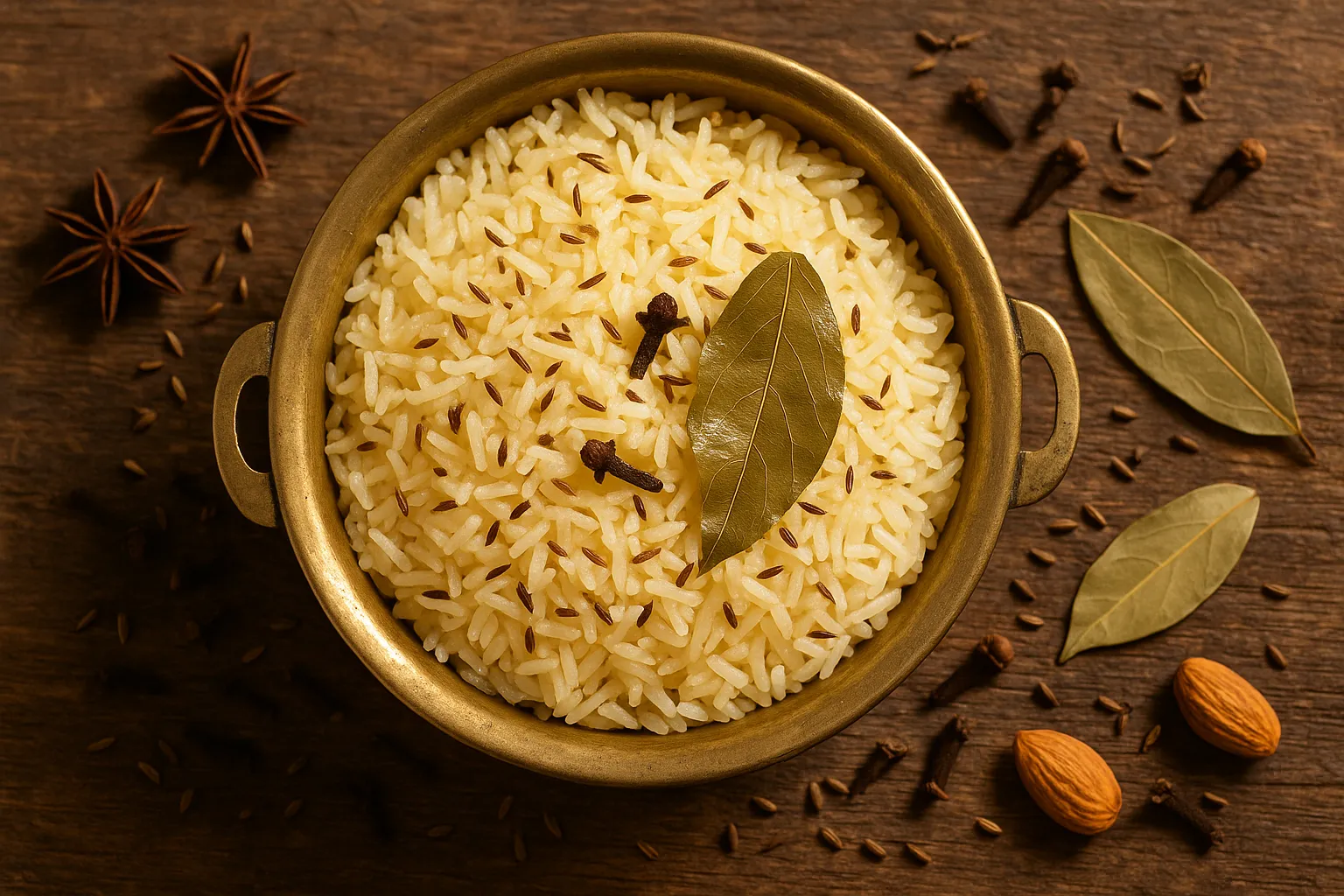Ghee Rice: Calories, Nutrition and Health Benefits
Aromatic basmati rice cooked in clarified butter, offering rich flavor and sustained energy for active lifestyles.
Quick Nutrition Facts
Per 100g Serving
| Nutrient | Amount |
|---|---|
| Calories | 150 kcal |
| Protein | 2.5g |
| Carbohydrates | 28g |
| Fiber | 0.4g |
| Sugars | 0.1g |
| Fat | 3g |
| Saturated Fat | 1.8g |
| Sodium | 2mg |
| Iron | 0.2mg |
| Magnesium | 12mg |
Macronutrient Breakdown

NUTRITIONIST INSIGHT
Ghee rice provides quick energy from basmati carbs while ghee's healthy fats slow digestion, offering more sustained energy than plain rice. The fat content also enhances absorption of fat-soluble vitamins from accompanying curries and vegetables.
Myth Busters
MYTH #1: Ghee Rice Is Too Fattening
TRUTH: At 150 calories per 100g, ghee rice is only slightly higher than plain rice (130 cal/100g). Ghee contains healthy saturated fats that support hormone production and vitamin absorption. Control portions, not ghee.
MYTH #2: Ghee Rice Causes High Cholesterol
TRUTH: Ghee has been shown in studies to have a neutral or beneficial effect on cholesterol when consumed in moderation. The key is portion control - use 1-2 tsp ghee per serving.
MYTH #3: White Rice Is Always Unhealthy
TRUTH: Basmati rice has a lower glycemic index (50-58) compared to regular white rice (70+) due to higher amylose content. When paired with vegetables and protein, it's a balanced meal component.
MYTH #4: Ghee Rice Should Be Avoided During Weight Loss
TRUTH: Small portions (80-100g) of ghee rice can fit into weight loss diets. The fat content provides satiety, potentially reducing overall calorie intake. Pair with high-fiber vegetables and lean protein for balanced nutrition.
MYTH #5: Oil Is Healthier Than Ghee for Cooking Rice
TRUTH: Ghee has a higher smoke point than most oils and contains butyrate, a short-chain fatty acid that supports gut health. Traditional preparation with ghee may be easier to digest than vegetable oils.
MYTH #6: Ghee Rice Has No Nutritional Value
TRUTH: Beyond energy from carbs, ghee provides vitamins A, D, E, and K, while basmati rice offers small amounts of B vitamins, iron, and magnesium. It's a vehicle for nutrient absorption from accompanying dishes.
NutriScore by Health Goals
| Health Goal | NutriScore | Why This Score? |
|---|---|---|
| Weight Loss |  | Calorie-dense at 150 cal/100g. Limit to 80-100g portions, choose brown basmati, pair with vegetables. |
| Muscle Gain |  | Excellent post-workout carb source for glycogen replenishment. Add protein-rich side dishes. |
| Diabetes Management |  | Moderate GI (58). Use brown basmati (GI 50), limit portions to 50-80g, always pair with protein and fiber. |
| PCOS Management |  | Moderate carb content affects insulin. Choose brown rice version, smaller portions, add vegetables and protein. |
| Pregnancy Nutrition |  | Provides sustained energy and healthy fats for fetal development. Ensure variety with dal and vegetables. |
| Viral/Flu Recovery |  | Easy to digest, provides quick energy, gentle on stomach. Ideal comfort food during illness. |
PERSONALIZED NUTRITION
Track your meals with NutriScan for personalized NutriScores based on your specific health goals!
Blood Sugar Response to Ghee Rice
Understanding how ghee rice affects your blood glucose helps with portion control and meal planning.
Typical Glucose Response Curve
*This chart shows typical blood glucose response for general healthy individuals. Individual responses may vary. Not medical advice.*
How to Flatten the Spike
Pairing carbohydrate-rich foods with protein, fat, and fiber significantly reduces blood sugar spikes:
- 🥘 Dal or lentil curry - Adds protein and fiber for slower digestion
- 🥗 Mixed vegetable curry - Provides fiber to slow carb absorption
- 🍗 Chicken or paneer curry - Protein slows glucose release
- 🥒 Raita with cucumber - Protein from yogurt, cooling effect
This combination creates a balanced meal that provides sustained energy without sharp glucose spikes.
Cultural Significance
Ghee rice, known as "Neychoru" in Kerala and "Ghee Bhat" in Karnataka, holds special cultural importance in South Indian cuisine.
In India:
- Traditional festival food served during Onam, Vishu, and weddings
- Considered auspicious and offered in temples as prasadam
- Essential component of South Indian sadya (feast) meals
- Ayurveda recommends ghee-cooked rice for better digestion and strength
- Regional variations include Jeera Rice, Kashmiri Pulao, and Coconut Ghee Rice
Global Variations:
- Middle Eastern: Pilaf with butter or ghee, nuts, and dried fruits
- Central Asian: Plov with lamb fat and spices
- Southeast Asian: Coconut oil rice with similar aromatic preparation
Compare & Substitute
Ghee Rice vs Similar Rice Dishes (Per 100g)
| Nutrient | 🍚 Ghee Rice | 🍚 Plain Basmati | 🍚 Jeera Rice | 🍚 Coconut Rice |
|---|---|---|---|---|
| Calories | 150 kcal | 130 kcal | 145 kcal | 165 kcal |
| Carbs | 28g | 28g | 27g | 26g |
| Fiber | 0.4g | 0.4g | 0.6g | 1.2g |
| Protein | 2.5g | 2.7g | 2.6g | 2.3g |
| Fat | 3g | 0.3g | 3.2g | 5g |
| Sodium | 2mg | 1mg | 4mg | 3mg |
| Iron | 0.2mg | 0.2mg | 0.3mg | 0.4mg |
| Best For | Energy boost | Weight loss | Digestion aid | Rich flavor |
Frequently Asked Questions
Is ghee rice good for weight loss?
Ghee rice is calorie-dense at 150 calories per 100g, making it moderate for weight loss goals. For weight management, limit portions to 80-100g, choose brown basmati for added fiber, use minimal ghee (1 tsp per serving), and pair with high-volume vegetables and lean protein.
Tips: Eat at lunch rather than dinner; avoid second servings; fill half your plate with vegetables.
Can diabetics eat ghee rice?
Diabetics can include ghee rice in moderation with careful portion control. Choose brown basmati (GI 50 vs white's 58), limit to 50-80g portions, always combine with protein-rich dal or chicken curry and fiber-rich vegetables to slow glucose absorption.
Monitoring: Check blood sugar 2 hours after eating; adjust portions based on individual response. The fat from ghee actually helps slow carbohydrate digestion.
How many calories are in ghee rice?
One serving (100g) of ghee rice contains approximately 150 calories, with 28g carbohydrates, 2.5g protein, and 3g fat. A typical restaurant serving (200g) provides around 300 calories.
For comparison, one cup cooked ghee rice (158g) has approximately 237 calories.
What are the main health benefits of ghee rice?
Key Benefits:
- Sustained Energy: Complex carbs provide lasting fuel for 3-4 hours
- Better Nutrient Absorption: Ghee's fat enhances absorption of vitamins A, D, E, K from vegetables
- Easier Digestion: Ghee is easier to digest than many cooking oils
- Satiety: Fat content promotes fullness, potentially reducing overall calorie intake
- Butyrate Content: Ghee provides butyrate that supports gut health
Is ghee rice healthier than regular rice?
Ghee rice has more calories and healthy fats compared to plain rice but offers nutritional advantages. Ghee provides fat-soluble vitamins A, D, E, and K; butyrate for gut health; and improved absorption of nutrients from accompanying dishes.
Choose ghee rice when: You need sustained energy, recovering from illness, or post-workout. Choose plain rice when: Strict calorie control, weight loss, or following a very low-fat diet.
What is the best time to eat ghee rice?
Depends on your goal:
- Weight Management: Lunch (12-2 PM) when metabolism is highest. Avoid dinner.
- Muscle Gain: Post-workout (within 90 minutes) for glycogen replenishment.
- General Health: Lunch provides sustained afternoon energy without evening calorie load.
- Athletes: Pre-competition meal (2-3 hours before) for sustained energy.
How much ghee rice should I eat in one meal?
Recommended portions:
- Weight Loss: 80-100g (1/2 cup cooked) = 120-150 calories
- Maintenance: 125-150g (3/4 cup cooked) = 190-225 calories
- Muscle Gain/Athletes: 150-200g (1 cup cooked) = 225-300 calories
- Diabetes: 50-80g (1/3 to 1/2 cup) = 75-120 calories
Always balance with vegetables (2 cups) and protein source (100g).
Can I eat ghee rice every day?
Yes, in moderation as part of a balanced diet. Daily consumption is acceptable if portions are controlled (100-150g), you maintain overall calorie balance, include variety with other grains (brown rice, millets, quinoa), and pair with protein and vegetables.
Caution: Excessive daily intake without variety may lead to nutrient gaps. Rotate with other whole grains for optimal nutrition.


 ChatGPT
ChatGPT  Claude
Claude  AI Mode
AI Mode  Perplexity
Perplexity 



